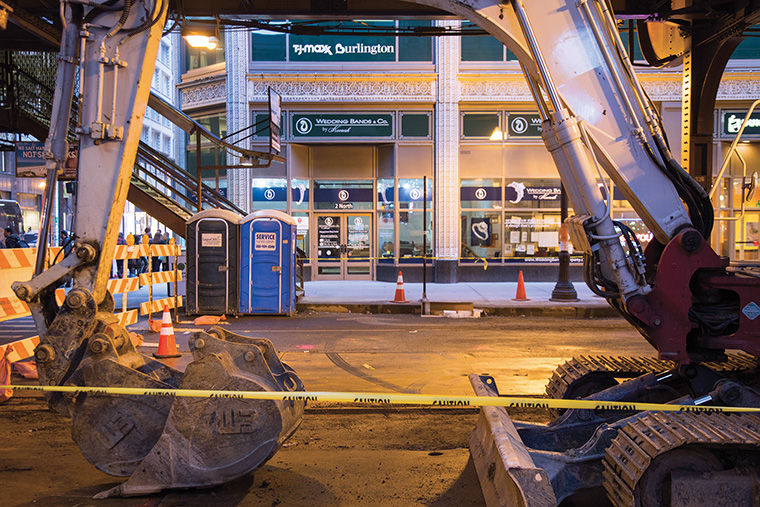Chicago Loop Alliance transforms Wabash Avenue into Magnificent Mile
The block of Wabash Avenue between Madison and Washington streets will be closed for next 18 months due to the construction of the new Wabash and Washington stop.
March 30, 2015
From Wacker Drive to Congress Parkway, the Chicago Loop Alliance is spearheading a new infrastructure project, “Layers of Transformation,” to transform Wabash Avenue into a premier Chicago tourist destination.
Michael Edwards, president and CEO of Chicago Loop Alliance, an organization contracted by the City of Chicago to generate city revenue, said the goal of the project is to draw tourists from Michigan Avenue and Millennium Park to Wabash Avenue.
The CLA’s plan is to beautify Wabash Avenue by adding brighter overhead street lights, establish ing a more effective street-cleaning system—including removing graffiti—and rerouting Chicago Transit Authority buses from Michigan Avenue and Millennium Park through Wabash, Edwards said.
Creating a visually appealing, luxurious environment with improved CTA service will show visitors what Wabash has to offer, Edwards said.
The first major development in the Wabash transformation project is the construction of an el station at Wabash and Washington. The construction of the el station is currently the largest project the CLA plans to undertake and is expected to require 18 months for completion. Beginning March 16, the Wabash/Madison stop that services the Brown, Pink, Green, Orange and Purple lines will no longer be operational, Edwards said.
Edwards said many neighborhood residents are apprehensive about the addition of the new stop.
“After seeing the ruckus between Madison and Washington, people are worried further renovations on Wabash will cause more disruption,” Edwards said.
At this point in the project, Edwards said the businesses on Jeweler’s Row, located on Wabash on the block between Madison and Washington streets, have the most concerns. Jeweler’s Row is currently closed due to the construction of the el stop. Because of this, businesses on Jeweler’s Row will be blocked off and may have fewer walk-in customers, he said.
Jason Zastrow, sales associate at R.L. Jewelers, 1 N. Wabash Ave., said he is most concerned about the holidays. He said business is good now because of the warm weather, and many people are walking place to place, but foot traffic decreases in brutal winter conditions.
“Come Christmas season, this is going to be the major concern because then people can’t get around,” Zastrow said. “They can’t valet. They can’t park anywhere around here within blocks and blocks of the neighborhood.”
Across the street from R.L. Jewelers, Koorosh Daneshgar, chief designer and CEO at Wedding Bands and Co., 2 N. Wabash Ave., said he is not worried about the construction hurting his business. He said most of his clients come into his store after finding him online and researching his work.
“It’s not like you go, ‘I’m going to walk [in] today and buy a $100,000 ring,’” Daneshgar said.
Edwards said he thinks the Wabash transformation project would benefit businesses on Jeweler’s Row in the long run because more tourists would visit the area, providing increased revenue.
The CLA will not undertake any other renovation projects until the el stop is complete, Edwards said. He said the other proposed projects depend on the outcome of the stop’s completion.
Edwards said the CLA planned the “Layers of Transformation” project after undertaking a five-year strategic plan to study the economic activity of the entire Loop area. During that time, the CLA held public panels and workshops for businesses and new residents to give their input about how to bring more tourists and residents to the downtown area. It was the first strategic plan study the alliance had done in many years, he said.
“The study was based upon what are our economic drivers, how are they performing and what does that mean in terms of what we should be doing,” Edwards said. “After the Great Recession of 2008, the world shifted, and so we wanted to better understand how downtown was performing within this sort of new economy, this new reality.”








